Unbagging Cherry Deluxe
Cherry Deluxe
#1
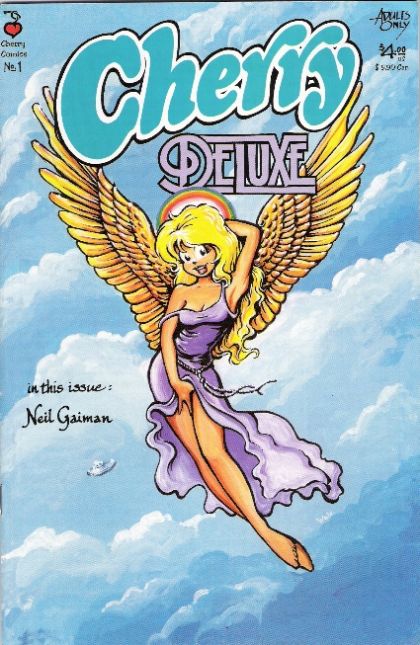
Release: Aug 1998
Cover: Aug 1998
Cherry Comics
Creators
| Writer | Neil Gaiman, Karen Murray |
| Artist | Larry Welz, Marc Hempel |
I’m still proud of my Cherry story.
Neil Gaiman
After backing a crowdfunded collection of stories from multiple well-known creators featuring Cherry Poptart, I decided I should take a look at a Cherry comic I already own that features a story by a well-known creator.
For the unfamiliar, Cherry Poptart is a sexually adventurous young woman – whom her creator Larry Welz wishes to stress is 18 – featured in a series of adult comics that recount not only her sexual adventures but those of her equally amorous mother and friends.
Creator Larry Welz rendered Cherry and friends in a style reminiscent of what you might find in Archie comics, providing something of a jarring contrast between the perceived innocence of the style and the explicit sexual acts being depicted.
In addition to featuring uninhibited sexual acts, most Cherry stories provide some amount of social commentary and pop culture parody. For example, one story featured a spoof of Back to the Future in which Cherry travels back in time and helps transform her mother from the button-downed shy girl she had been into the wanton hussy she knows her to be.
How well the humor and commentary are executed is debatable, but while there are a lot of unfortunate aspects that have not aged well – and weren’t exactly doing that great even decades ago – there are plenty of aspects of the stories that are fun (and sexy) beyond the basic “Archie comics, but dirty” high concept.
After all, as noted, there are plenty of mainstream talents who saw value in telling stories featuring Cherry, such as Neil Gaiman, who wrote the main story in this issue.
Gaiman’s story both is and is not a typical Cherry tale. It is, in that Cherry is often featured in stories of assorted genres, but is not in that it isn’t really about Cherry at all, featuring entirely different characters in an entirely different locale, albeit characters who resemble Cherry and friends. Think of it like one of those episodes of a TV show in which one of the characters has a dream or tells a story in which other characters from the show perform certain roles.
The story opens in a place called Breme where not much of anything happens, though we are presented with something happening: an innkeeper dies and is buried.
As do all places, per the narration, Breme has an angel and a demon who watch over it and determine where the souls of its departed will ultimately reside. Normally, they don’t have much to argue about, but the innkeeper’s soul proves to be an exception.
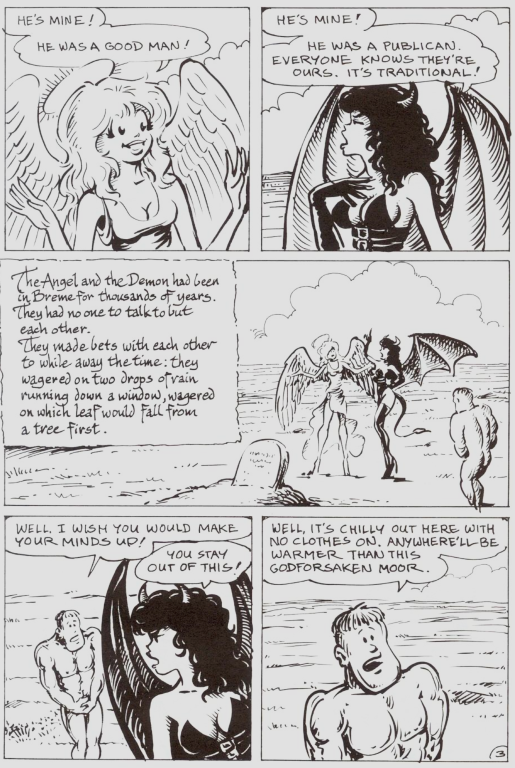
Seeing the naked soul gives the demon an idea about a wager that she and the angel can make to settle this dispute.
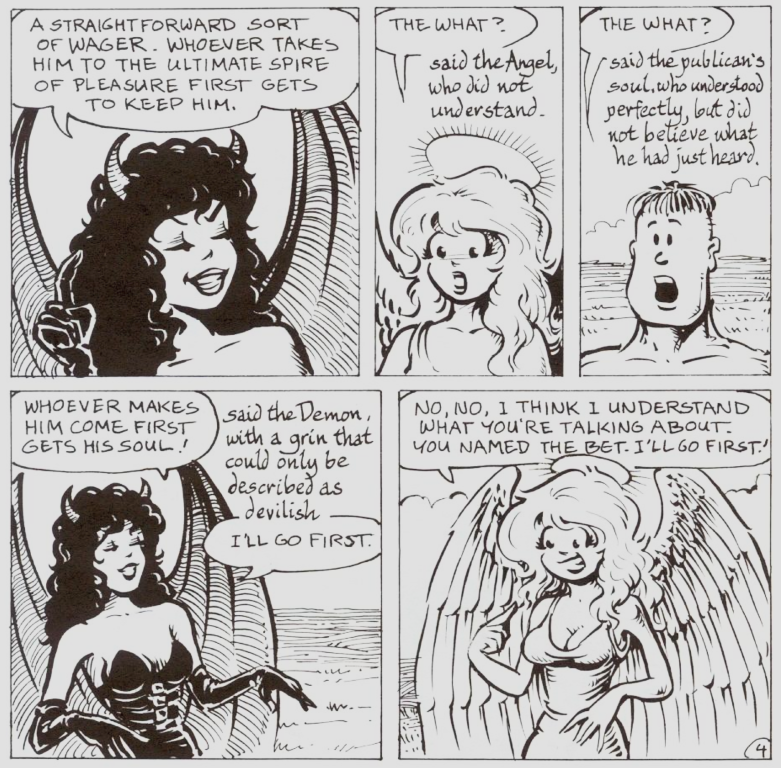
And so the angel – who, by the way, is Cherry – does indeed go first. However, while she is satisfied by her efforts, the innkeeper has not…arrived, and so the demon takes her turn, demonstrating devilish tricks that the angel would never have thought of on her own.
Still, even she is not able to fully seal the deal, and the angel realizes that while she’d had her fun with the innkeeper, maybe that’s not the only fun there was to be had.
She looks at the demon and wonders, “What that tail do?”
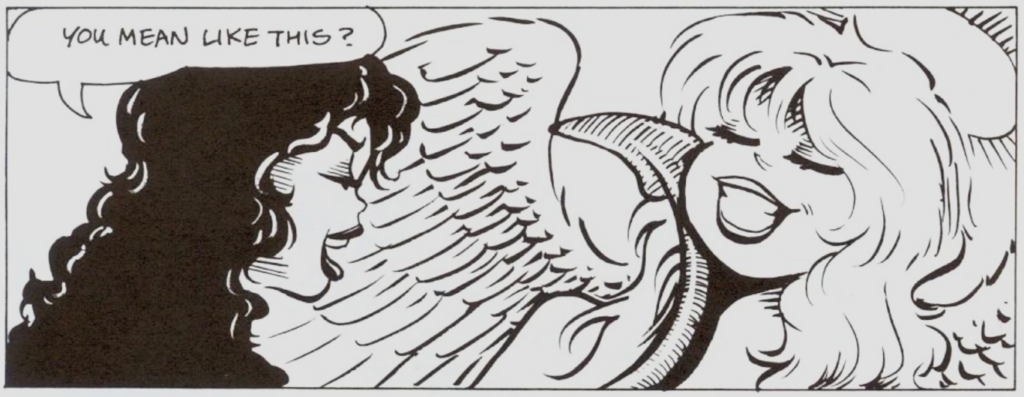
While the angel and demon are distracted, the innkeeper’s soul manages to slip away. Eventually, when they come up for air, they notice his absence and head off in search for him.
They soon find that he has returned to the inn, and more specifically, to his bed.
With his wife.
I won’t spoil the ending, but I will say that in the end the innkeeper manages to outwit both angel and demon.
However, it wasn’t a total loss for them, as the angel and demon had on this day found a better way to while away their time than to engage in constant wagers…
The story reminds me a little of the Desire story in Gaiman’s Sandman: Endless Nights, which was illustrated by Milo Manara, an artist who, like Welz primarily does adult comics, and also a bit of Good Omens, with the angel and demon who only have each other for company.
Which is to say that it’s a tale told with typical Gaiman flair, with wry narration and amusing asides.
This story didn’t need to be a Cherry story, as there’s little about it that’s really unique to Cherry, but at the same time a Cherry comic is an excellent medium in which to tell it. Having Cherry play the part of an angel who is ultimately not as pure as she appears is really in line with the core idea of the character and comic.
While it isn’t a narrative based on the established characteristics of Cherry and friends, it’s not that far removed from a typical Cherry story, but it is better than a typical Cherry story.
Welz does a fine job of rendering the setting, which differs from the modern setting of most Cherry stories, and, of course, in depicting the various acts that the angel, demon, innkeeper, and the innkeeper’s wife engage in, never straying from that teen comedy comic style he’s often been threatened with litigation for.
I like that there’s a mix of straight prose in with the dialogue, as at times it adds some color commentary to what’s being spoken. It leads me to wonder if Gaiman wrote this as a prose short story rather than as a comic script.
The remainder of the issue is rounded out by a Cherry pin-up, a two-page non-Cherry strip by Marc Hempel, and a more typical Cherry story featuring her mom that’s written by Karen Murray.
In that story, Cherry’s mom tells her about the time talk radio personality H. Hardon Cappy (a parody of G. Gordon Liddy) attempted to recruit her to assist in “Plottergate.”
After her mom finishes the story, Cherry realizes that Cappy is broadcasting from a local station and suggests that they pop in to surprise him.
They do, and find that his middle name is no longer accurate, but that he can at least use his mouth to do something more useful than spew nonsense over the airwaves.
After they finish up and are driving away, they consider what they might do as a follow-up…
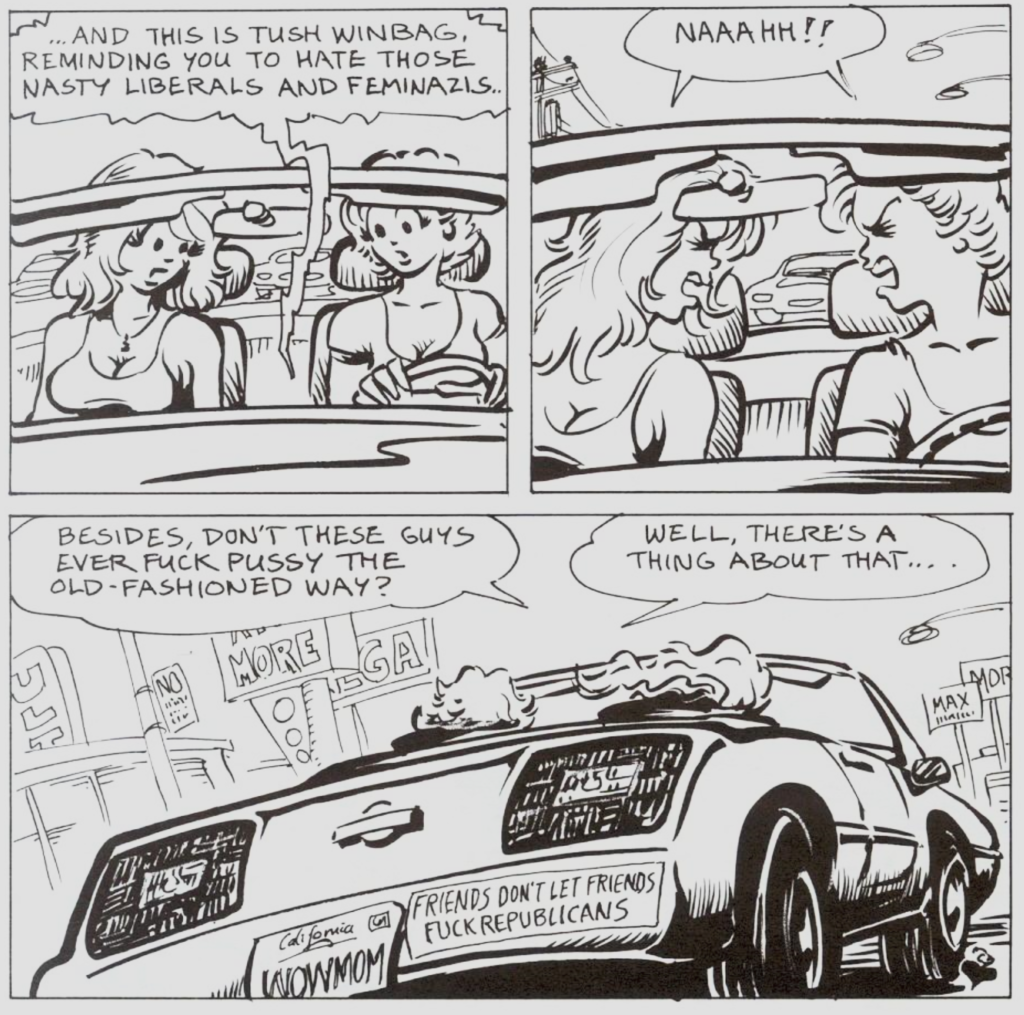
Honestly, that bumper sticker at the end is the best part of the story which is mostly just a confusing mess, which the story itself seems to realize, as there are multiple instances of confused characters asking, “What is going on?”
I wanted to keep things relatively clean while talking about a dirty comic, so I didn’t include any of the copious sex scenes, but trust me, they’re in there, and they’re explicit.
While she was a product of the 1980s’, Cherry was really born out of the underground comix of the ’60s and ’70s, carrying forward a lot of that sensibility – and baggage, particularly when it comes to race – being deliberately provocative through both style and substance.
Cherry has the look of being kids’ stuff while very much not being for kids which gives the character and her stories a transgressive power, but along with the depravity there is also a great deal of flexibility, as is evidenced by the two radically different stories contained in this single volume.
Cherry stories can be puerile and prurient parodies or fun fantastical fables in not-quite equal measure, but often within the same story.
Whether or not you would enjoy Cherry stories depends entirely on your sensibilities and to what extent you enjoy having them shocked, but if you like Neil Gaiman stories and can at least put up with some cartoonishly sexually explicit content, this is the one Cherry comic to read if you only read one.

Born and raised in the sparsely populated Upper Peninsula of Michigan, Jon Maki developed an enduring love for comics at an early age.



1 thought on “Unbagging Cherry Deluxe”